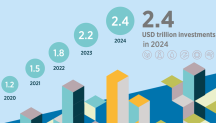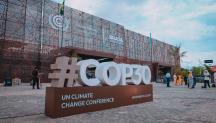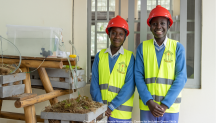

The 360 Gigawatts Reason to Boost Finance for Energy Storage Now
Newsletter
Our world has a storage problem.
As the technology for generating renewable energy has advanced at breakneck pace – almost tripling globally between 2011 and 2022 – one thing has become clear: our ability to tap into renewable power has outstripped our ability to store it.
Storage is indispensable to the green energy revolution. The most abundant sources of renewable energy today are only intermittently available and need a steady, stored supply to smooth out these fluctuations. Energy storage technologies are also the key to lowering energy costs and integrating more renewable power into our grids, fast.
If we can get this right, we can hold on to ever-rising quantities of renewable energy we are already harnessing – from our skies, our seas, and the earth itself.
The gap to fill is very wide indeed. The International Renewable Agency (IRENA) ran the numbers, estimating that 360 gigawatts (GW) of battery storage would be needed worldwide by 2030 to keep rising global temperatures below the 1.5°C ceiling. Only that will allow us to get almost 70% of our energy from renewable sources. The world urgently needs more pumped hydropower storage, more decentralized mini-grids, and bigger, better, and more recyclable electrochemical batteries. We need accelerated testing of new technologies, like green hydrogen, thermal storage using molten salts, or flywheel-based mechanical solutions.
When it comes to ramping up storage in developing countries, many creative actors are already working hard to get the mix right: setting out regulatory frameworks that can successfully monetize the value of new storage technologies, pioneering innovative new business models, and building the kind of infrastructure needed for a huge scale-up.
One large missing piece has been funding.
Storage projects are risky investments: high costs, uncertain returns, and a limited track record. Only smart, large-scale, low-cost financing can lower those risks and clear the way for a clean future.
The Climate Investment Funds (CIF) – the world’s largest multilateral fund supporting energy storage in developing countries – is working on bridging this gap. CIF is the biggest funder globally of mini-grids, a proven game-changer for isolated communities. A single rural electrification project in Mali has given almost a half a million people access to cleaner, cheaper and more reliable electricity, by replacing costly and polluting diesel generators with a hybrid (battery storage and diesel) mini-grid system. CIF is also fueling the next frontier in energy storage: $70m in CIF funding is set to help kick-start a $9 billion energy revolution in Brazil, which includes substantial investments in energy storage, such as pumped hydro and green hydrogen development.
And in the Maldives, CIF is supporting the government’s efforts to hit one of the most ambitious climate targets in the world: net zero by 2030. Getting there will take a concerted effort. While sunshine is plentiful, the population of the Maldives is spread across more than 200 islands and is 95% reliant on generators driven by expensive and highly-polluting diesel.
In 2017, CIF and the Maldives embarked on our signature partnership model: the country led the process, backed by large-scale, long-term, and low-cost finance from ourselves and our multilateral development bank partners (in this case, the Asian Development Bank and the World Bank).
Within four years (from 2017 to 2021), the cost of electricity dropped from 21 cents to just 11 cents. And that initial support package has spurred an ambitious follow-on initiative expected to mobilize an incredible $152.4 million in new investment, install 90 MWh of battery storage, and save the country $42.38 million annually on diesel imports.
Over 4,000 miles away and with a population one hundred times larger, another country is making great strides in energy storage. Thanks to $250 million in concessional finance from CIF, South Africa is soon to see 100 MW of new storage capacity come online. With technical assistance provided under this project, national grid codes and other essential policies were created, ultimately leading to 455 MW of battery storage being backed by private investors – to the tune of approximately $605 million.
Many other developing countries want to move away from fossil fuels, but have been blocked by the costs of getting energy storage systems rolled out at scale.
That’s why CIF has just launched a first-of-its-kind $400 million Global Energy Storage Program (GESP), dedicated to breakthrough storage solutions. This is the largest climate funding vehicle in the world solely focused on energy storage.
Twelve new projects across the developing world have already been approved, including in Bangladesh, Brazil, Colombia, Haiti, Honduras, India, Indonesia, the Maldives, and Ukraine. In the next three years, CIF plans to create 1.8 GW of new storage capacity and integrate an additional 16 GW.
And the best part? Every dollar invested is expected to generate up to $16 in co-financing. It’s time to get that ratio working, where it matters most.
Originally published on CleanTechnica.

Expert Insight by:
Daniel Morris
Clean Energy Lead, Climate Investment Funds (CIF)

Expert Insight by:
Francisco Boshell
Head of Innovation and End-Use Applications, International Renewable Energy Agency (IRENA)
© IRENA 2025
Unless otherwise stated, material in this article may be freely used, shared, copied, reproduced, printed and/or stored, provided that appropriate acknowledgement is given of the author(s) as the source and IRENA as copyright holder.
The findings, interpretations and conclusions expressed herein are those of the author(s) and do not necessarily reflect the opinions of IRENA or all its Members. IRENA does not assume responsibility for the content of this work or guarantee the accuracy of the data included herein. Neither IRENA nor any of its officials, agents, data or other third-party content providers provide a warranty of any kind, either expressed or implied, and they accept no responsibility or liability for any consequence of use of the content or material herein. The mention of specific companies, projects or products does not imply that they are endorsed or recommended, either by IRENA or the author(s). The designations employed and the presentation of material herein do not imply the expression of any opinion on the part of IRENA or the author(s) concerning the legal status of any region, country, territory, city or area or of its authorities, or concerning the delimitation of frontiers or boundaries.




